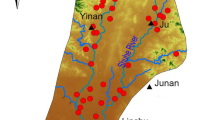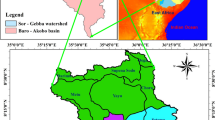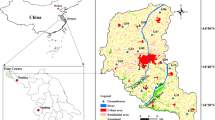Abstract
The availability of lithium resources is of great significance for the development of modern technologies, as well as for civil and military industries. The Qinghai-Tibet Plateau is a region known for its abundance of lithium-rich salt lakes. However, the specific origin of lithium in these lakes is still unknown, which hinders the advancement of the lithium resource business in this region. To research this issue, this study involved the collection of 20 samples from Lakkor Co Salt Lake on Qinghai-Tibet Plateau, encompassing samples of surface brine, cold springs, fresh lakes, and recharge rivers. The composition of anions and cations in these samples was determined. Furthermore, the analysis extensively utilized the Piper three-line diagram, Gibbs model, and ion proportion coefficient. The findings of this study indicate that as the moves from the recharge water system to salt lake, there is a transition in water type from strong carbonate to moderate carbonate and weak carbonate, as well as Na sulfate. This research based on a similar source of both lithium and boron, utilized ion correlation analysis and boron isotope study in the Lakkor Co area, and analyzed the source and transporting process of lithium. The main origin of lithium in Lakkor Co is the dissolution of lithium-rich rocks, recharge water systems, and deep hydrothermal fluids. These findings are highly significant in enhancing the foundational data of lithium-rich brine resources in the Qinghai-Tibet Plateau and are beneficial for assessing the future development of such deposits.







Similar content being viewed by others
Data availability
Data will be made available on request.
References
Andrews E, Pogge von Strandmann PAE, Fantle MS (2020) Exploring the importance of authigenic clay formation in the global Li cycle. Geochim Cosmochim Acta. 289:47–68.
Başak B, Alagha O (2004) The chemical composition of rainwater over Büyükçekmece Lake, Istanbul. Atmos Res. 71(4):275–288. https://doi.org/10.1016/j.atmosres.2004.07.001
Boschetti T, Toscani L, Iacumin P, Selmo E (2017) Oxygen, hydrogen, boron and lithium isotope data of a natural spring water with an extreme composition: A fluid from the dehydrating slab? Aquat Geochem. 23:299–313. https://doi.org/10.1007/s10498-017-9323-9
Chen YH (1983) Salt evolution sequence and distribution law of some trace elements in yellow sea water at 25 °C constant temperature evaporation. J Geol. 04:379–390.
Chen XS, Zhao B, Li LP, Liu CQ, Zhang ZG (2020) Discussion on the ore-forming geological laws and prospecting prospects of Salt Lake minerals in the Arizacangchaka Lakkor Co area. J Salt Lake Res. 1–12. http://kns.cnki.net/kcms/detail/63.1026.P.20220719.1112.002.html
Chetelat B, Gaillardet J, Freydier R, Négrel P (2005) Boron isotopes in precipitation: Experimental constraints and field evidence from French Guiana. Earth Planet Sci Lett. 235:16–30.
Dewey JF, Bird JM (1971) Origin and emplacement of the ophiolite suite: Appalachian ophiolites in Newfoundland. J Geophys Res. 76:3179–3206. https://doi.org/10.1002/9781118782149.ch24
Dilek Y, Furnes H (2011) Ophiolite genesis and global tectonics: Geochemical and tectonic fingerprinting of ancient oceanic lithosphere. Geol Soc Am Bull. 123:387–411. https://doi.org/10.1130/B30446.1
Dong H (2019) Study on the mechanism of lithium mineralization in the brine of Laguocuo Salt Lake in Tibet. Dissertation, China University of Geosciences (Beijing). https://doi.org/10.27493/d.cnki.gzdzy.2019.001241
Geological Survey Institute of Tibet (2011) Autonomous region report on evaluation results of potassium salt mineral resources potential in tibet autonomous region lhasa. Geological Survey Institute of Tibet Autonomous Region.
Gibbs RJ (1970) Mechanisms controlling world water chemistry. Science. 170:1088–1109. https://doi.org/10.1126/science.170.3962.1088
Grosjean C, Miranda PH, Perrin M (2012) Assessment of world lithium resources and consequences of their geographic distribution on the expected development of the electric vehicle industry. Renew Sustain Energy Rev. 16:1735–1744. https://doi.org/10.1016/j.rser.2011.11.023
He TL, Xu JX, Han JB, Wang GQ (2017) Hydrogeochemical characteristics of Kulamulekesayi-Alaer river valley in northwestern Qaidam Basin. Salt Lake Res. 25(2):21–27.
He MY, Luo CG, Yang HJ, Li YL, Deng L, Zhang XY, Yang KY (2020) Sources and a proposal for comprehensive exploitation of lithium brine deposits in the Qaidam Basin on the northern Tibetan Plateau, China: evidence from Li isotopes. Ore Geol Rev. https://doi.org/10.1016/j.oregeorev.2019.103277
Hemming NG, Hanson GM (1994) A procedure for the isotopic analysis of boron by negative thermal ionization mass spectrometry. Chem Geol. 114:147–156.
Hong RC, Gao CL, Yu JQ, Min XY, Cheng AY, Zhang LS, Xu H (2017) Comparison of metallogenic conditions and study on deposit model of typical salt lake boron deposits in Qinghai-Tibet Plateau. Salt Lake Res. 25(01):8–18.
Kesler SE, Gruber PW, Medina PA, Keoleian GA, Wallington TJ (2012) Global lithium resources: relative importance of pegmatite, brine and other deposits. Ore Geol Rev. 48(5):55–69. https://doi.org/10.1016/j.oregeorev.2012.05.006
Li QK (2020) Study on the source, migration and enrichment of lithium in the Nalingele River basin and the salt lake downstream under the constraint of multiple indicators. Dissertation, University of Chinese Academy of Sciences (Qinghai Salt Lake Research Institute, Chinese Academy of Sciences). https://doi.org/10.27577/d.cnki.gqhyy.2020000006
Li T, Ni SB (1990) Chemical element abundance of the Earth and crust. Geological Publishing House, Beijing.
Li Q, Fan Q, Wang J, Qin Z, Shan F (2019) Hydrochemistry, distribution and formation of lithium-rich brines in salt lakes on the Qinghai-Tibetan Plateau. Minerals-Basel. 9(9):528. https://doi.org/10.3390/min9090528
Li YL, Miao WL, Zhang XY, He MY, Tang QL, Yang KY, Li YS, Han JL, Zhao X (2021) Hydrochemical characteristics and source of salt forming elements of Kushui Lake lithium rich salt lake in West Kunlun region. Earth Sci. 46(11):4161–4174.
Li BK, Cheng HD, Ma HZ (2022a) Boron isotope geochemistry of the Lakkor Co Salt Lake (Tibet) and its geological significance. Geofluids. https://doi.org/10.1155/2022/3724800
Li JS, Li X, Zhang QS, Wei Y (2022b) Analysis of ore-controlling factors of the lithium deposit in Jibuchaka-Laguoco salt lake, Gaize County, Tibet. Geol Prospect Pap. 37(4):437–446. https://doi.org/10.6053/j.issn.1001-1412.2022.04.006
Liu ML, Guo QH, Wu G, Guo W, She WY, Yan WD (2019) Boron geochemistry of the geothermal waters from two typical hydrothermal systems in Southern Tibet (China): Daggyai and Quzhuomu. Geothermics. 82:190–202. https://doi.org/10.1016/j.geothermics.2019.06.009
Liu HY, Zeng QG, Wang Y, Mao GZ (2020) Petrology, zircon U-Pb ages and geochemical characteristics of the Laguocuo ophiolite melange in Tibet. Geol Bull China. 39(Z1):164–176
Liu CL, Yu XC, Yuan XY, Li RQ, Yao FJ, Shen LJ, Li Q, Zhao YY (2021) Characteristics, distribution rules and metallogenic dynamic model of salt lake brine-type lithium deposits in the world. Acta Geol Sin-Engl. 95(7):2007–2029. https://doi.org/10.3969/j.issn.0001-5717.2021.07.001
Liu DR, Xu LJ, Li SC, Cao K, Tuya LWQ, Liu QL (2023) Research progress of recovery of strategic metal lithium from fly ash. Inorg Salt Ind. 55(01):56–63. https://doi.org/10.19964/j.issn.1006-4990.2022-0471
Luo YB, Zheng MP, Ren YQ (2017) Metallogenic correlation of special salt lake and hydrotherm, Qinghai-Tibet Plateau. China Sci Technol Rev. 35(12):44–48. https://doi.org/10.3981/j.issn.1000-7857.2017.12.006
Lü GR (2013) Geological characteristics and genesis of Laguocuo Salt Lake in Gaize County, Tibet Autonomous Region. Dissertation, China University of Geosciences (Beijing).
Lü YY, Zheng MP, Zhao P, Xu RH (2014) Geochemical processes and origin of boron isotopes in geothermal water in the Yunnan—Tibet Geothermal Zone. Sci China Earth Sci (Ser D) 44(9):1968–1979 (in Chinese).
Munk LA, Hynek SA, Bradley DC, Boutt D, Labay K, Jochens H (2016) Lithium brines: A global perspective. Soc Econ Geol. 18:339–365. https://doi.org/10.5382/Rev.18.14
Nicolas A (1989) Structures of ophiolites and dynamics of oceanic lithosphere. Kluwer Academic Publishers, Dordrecht, pp 289–311.
Rao JP, Jia QX, Liu XF, Wang HP, Luo YH (2019) Morphology, hydrology and hydrochemical characteristics of Tibetan Deborico Lakkor Co lake chain. Acta Geogr Sin. 40(05):737–746.
Rosenthal Y, Lam P, Boyle EA, Thomson J (1995) Authigenic cadmium enrichments in suboxic sediments: Precipitation and postdepositional mobility. Earth Planet Sci Lett. 132(1):99–111. https://doi.org/10.1016/0012-821X(95)00056-I
Song PS, Xiang RJ (2014) Development and utilization of lithium resources in salt lakes and suggestions for the development of lithium industry in China. Miner Depos. 33(5):977–992. https://doi.org/10.16111/j.0258-7106.2014.05.007
Sun R, Zhang XQ, Zheng D (2013) Spatial variation andits causes of water chemical property in Yamzhog Yumco Basin. South Tibet Acta Geogr Sin. 68(1):36–44 (in Chinese with English abstract).
Tan HB, Chen J, Rao WB, Zhang WJ, Zhou HF (2012) Geothermal constraints on enrichment of boron and lithium in salt lakes: An example from a river-salt lake system on the northern slope of the eastern Kunlun Mountains, China. J Asian Earth Sci. 51:21–29.
Tan HB, Zhang YF, Zhang WJ, Kong N, Zhang Q, Huang JZ (2014) Understanding the circulation of geothermal waters in the Tibetan Plateau using oxygen and hydrogen stable isotopes. Appl Geochem. 51:23–32. https://doi.org/10.1016/j.apgeochem.2014.09.006
Tang Y, Zhai QG, Hu PY, Wang W (2021) Genesis of plagioclase in Laguocuo ophiolite in the western section of Bangong Nujiang suture zone and its constraints on the evolution of the Central Tethys Ocean. Geol Bull China. 40(08):1265–1278.
Tribovillard N, Algeo TJ, Lyons T, Riboulleau A (2006) Trace metals as paleoredox and paleoproductivity proxies: An update. Chem Geol. 232(1/2):12–32. https://doi.org/10.1016/j.chemgeo.2006.02.012
Vikström H, Davidsson S, Höök M (2013) Lithium availability and future production outlooks. Appl Energy. 110(110):252–266. https://doi.org/10.1016/j.apenergy.2013.04.005
Wang RJ (1983) Three line diagram and its hydrogeological interpretation. Geotech Investig Surv. 06:6–11.
Wang QG, Sha ZJ, Hu JF, Kong FC (2017) Research progress on material source and ore-forming fluid of lithium in lithium rich salt lakes. Salt Lake Res. 25(03):74–80.
Wen HG, Zheng RC, Qing HR, Fan MT, Li YN, Gong BS (2014) The Cretaceous lacustrine hydrothermal sedimentary primary dolomite in the Qingxi Sag of the Jiuquan Basin on the northern edge of the Qinghai Tibet Plateau. Chin Sci (Earth Sci). 44(4):591–604.
Xiao YK, Li SZ, Wei HZ, Sun AD, Liu WG, Zhou WJ, Zhao ZQ, Liu CQ, Swihart GH (2007) Boron isotopic fractionation during seawater evaporation. Mar Chem. 103:382–392.
Xiao J, Zhao ZQ, Bouchez J, Ma XL, Philip AE, Strandmann PV, Araoka D, Yoshimura T, Zakir Hossain HM, Kawahata H, Jin ZD (2023) Geothermal input significantly influences riverine and oceanic boron budgets. Earth Planet Sci Lett. 621:118397. https://doi.org/10.1016/j.epsl.2023.118397
Yan LJ, Zheng MP (2015) The response of lake variations to climate change in the past forty years: a case study of the northeastern Tibetan Plateau and adjacent areas, China. Q Int. 371:31–48. https://doi.org/10.1016/j.quaint.2014.12.057
Yu SY, Liu M, Zhao YY, Zheng MP (2022) Hydrochemical characteristics of large-scale lithium-boron mine basin in the Mami Co Saline Lake. Tibet Acta Geogr Sin. 96(06):2195–2205. https://doi.org/10.19762/j.cnki.dizhixuebao.2022001
Zhang PX (1987) Salt lakes in Qaidam Basin. Science Press, Beijing, p 235.
Zhang JW (2019) Lithium isotope behavior during granite weathering and its environmental implications. Dissertation, China University of Geosciences.
Zhang QG, Kang SC, Wang FY, Li CL, Xu YW (2008) Major ion geochemistry of Nam Co Lake and its sources. Tibetan Plateau Aquat Geochem. 14(4):321–336. https://doi.org/10.1007/s10498-008-9039-y
Zheng MP, Liu WG, Xiang J, Jiang ZT (1983) Salt Lakes in Tibet. Geol Sci. 2:184–194.
Zheng MP, Xiang J, Wei XJ, Zheng Y (1989) Tibetan plateau salt lake. Science and Technology Press, Beijing.
Zheng XY, Zhang MG, Xu X, Li BX (2002) Records of salt lakes in China, 3rd edn. Science Press, Beijing.
Acknowledgements
This work was supported by Shaanxi Provincial Natural Science Foundation for Distinguished Young Scholars (2022JC); NSFC (41930863, 42173023) and The Science and Technology Plan Project of Qinghai Province Incentive Fund 2023.
Author information
Authors and Affiliations
Contributions
ZYLi: Conceptualization; Investigation; data curation; writing—original draft. BKL: Investigation; resources. M-YH: Conceptualization; supervision; funding acquisition. XQW: Supervision; writing—reviewing and editing. JDZ: Writing—reviewing and editing.
Corresponding authors
Ethics declarations
Conflict of interest
The authors declare that they have no conflict of interest.
Rights and permissions
Springer Nature or its licensor (e.g. a society or other partner) holds exclusive rights to this article under a publishing agreement with the author(s) or other rightsholder(s); author self-archiving of the accepted manuscript version of this article is solely governed by the terms of such publishing agreement and applicable law.
About this article
Cite this article
Li, Z.Y., Li, B.K., He, MY. et al. The source of lithium in Lakkor Co Salt Lake on Qinghai-Tibet Plateau, China: evidence from hydrochemical characteristics and boron isotope. Acta Geochim (2024). https://doi.org/10.1007/s11631-024-00697-z
Received:
Revised:
Accepted:
Published:
DOI: https://doi.org/10.1007/s11631-024-00697-z




